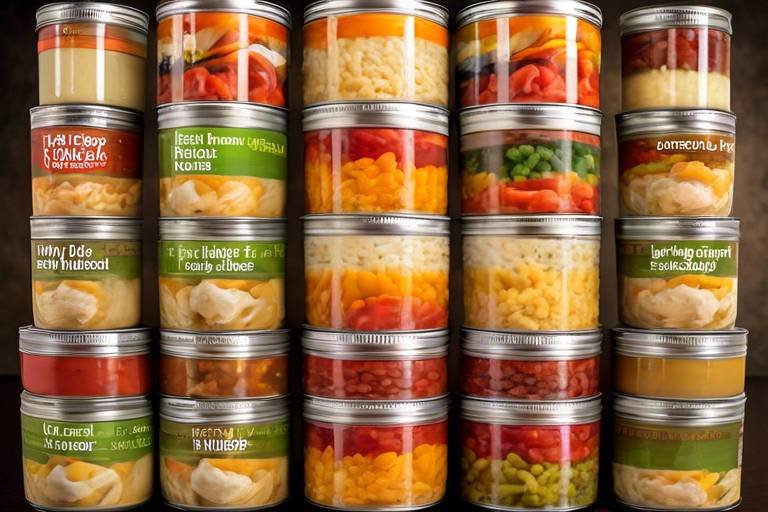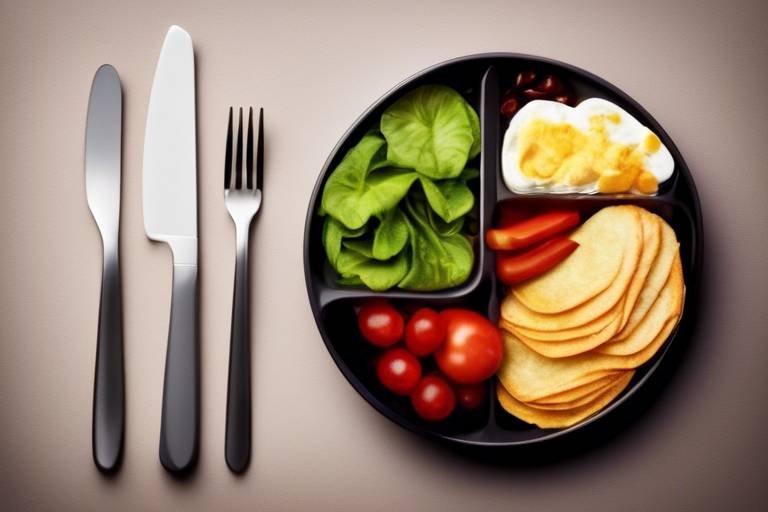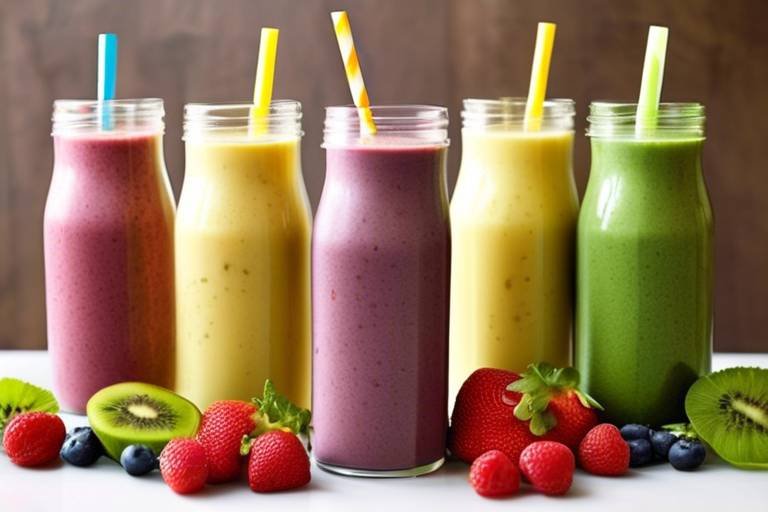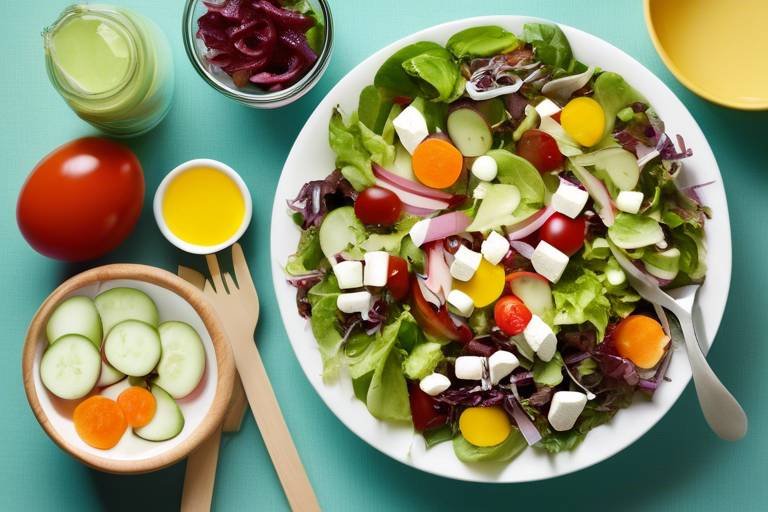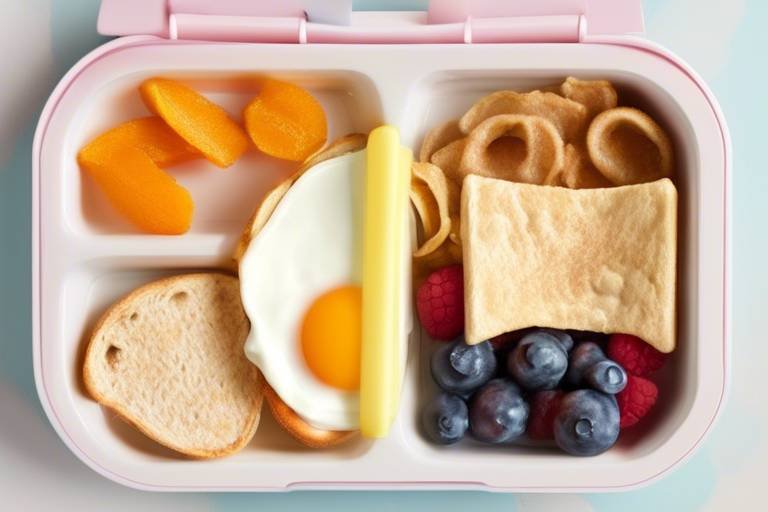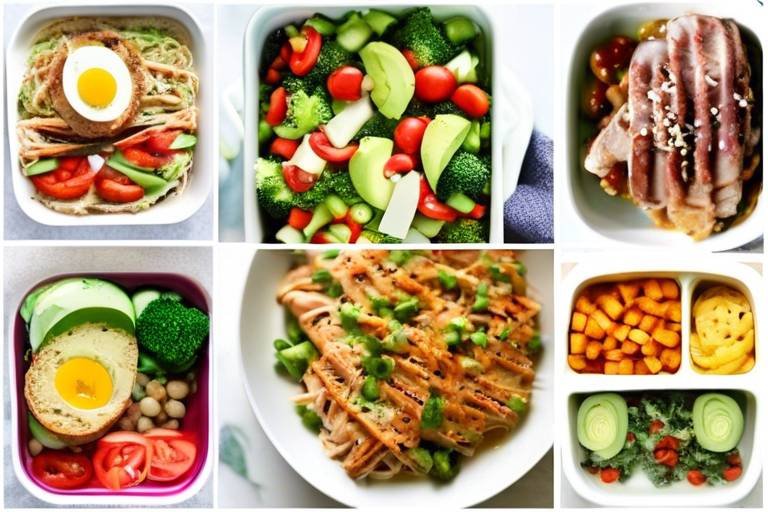How to Make Healthy Family Meals with Canned Foods
In today's fast-paced world, preparing healthy meals for the family can sometimes feel like a daunting task. However, canned foods can be a game-changer, offering a convenient and nutritious solution to your cooking challenges. Imagine opening up your pantry to find a treasure trove of ingredients that can help you whip up a delicious meal in no time! Canned foods are not just a backup plan; they can be the star of your kitchen, providing essential nutrients while saving you time and effort. So, how can you make the most of these versatile ingredients? Let’s dive into the benefits, tips, and recipes that will turn your family meals into a delightful experience without breaking a sweat!
Canned foods are often rich in nutrients and can be a cost-effective and convenient option for families. They are harvested at peak ripeness and canned within hours, locking in their nutritional value. This means that, contrary to popular belief, canned fruits and vegetables can be just as healthy as their fresh counterparts! Plus, they have a long shelf life, making them an excellent choice for meal planning. Think about it: having a can of beans or tomatoes on hand means you can easily throw together a hearty stew or a refreshing salad without a last-minute grocery run. And let’s not forget about the cost savings—canned foods can help stretch your budget while still keeping your family well-fed and satisfied.
Not all canned foods are created equal, and being selective is key to maintaining a healthy diet. When shopping, look for options that are low in sodium, sugar, and preservatives. A little label-reading goes a long way! Here’s a quick guide to what to look for:
| Canned Food Type | What to Check For |
|---|---|
| Vegetables | Low sodium, no added sugars |
| Fruits | In juice or water, not syrup |
| Beans | Low sodium or rinsed to reduce sodium |
By making informed choices, you can ensure that your family is getting the most out of these convenient ingredients.
Deciphering nutritional labels can be challenging. Start by focusing on the serving size—this helps you understand how much you’re actually consuming. Next, check the calories and nutritional content per serving. Look for products that offer a good amount of fiber and protein while keeping added sugars and unhealthy fats to a minimum. If you see any unfamiliar ingredients, it might be a red flag. Remember, the fewer the ingredients, the better!
Choosing low-sodium canned foods can significantly benefit your family's health. High sodium intake is linked to various health issues, including hypertension and heart disease. By opting for low-sodium alternatives, you can enjoy the same great taste without the health risks. Many brands now offer low-sodium versions of popular canned goods, so keep an eye out for these when you shop. Your heart will thank you!
When it comes to canned foods, you might wonder whether to go organic or stick with conventional options. Organic canned foods are typically made from ingredients grown without synthetic pesticides or fertilizers, which can be better for the environment and your health. However, conventional canned foods can still be nutritious and cost-effective. It ultimately comes down to your family’s values and budget. If you can, try to incorporate a mix of both into your meals!
Incorporating canned foods into your meal planning can save time and reduce food waste. Think of canned foods as your trusty sidekick in the kitchen. You can create a variety of meals that are both balanced and delicious. For instance, a simple chili can be made with canned beans, tomatoes, and corn, providing a hearty meal that’s packed with nutrients. By planning your meals around what you already have in your pantry, you can avoid those frantic last-minute grocery trips!
Now that you know the benefits and how to choose the right canned foods, let’s get to the fun part—cooking! Here are a couple of quick and easy recipes that highlight canned foods:
One-pot meals are perfect for busy families. They’re not only easy to prepare but also make cleanup a breeze. Consider making a canned vegetable stew with your favorite canned veggies, some broth, and spices. Just toss everything into a pot and let it simmer! Your family will love the rich flavors, and you’ll love the simplicity.
Canned foods can also be transformed into healthy snacks. Try making bean dip with canned black beans, garlic, and lime juice. Serve it with fresh veggies or whole-grain crackers for a nutritious snack that’s sure to satisfy. You can also whip up a quick fruit salad using canned peaches, pineapple, and a sprinkle of cinnamon for a sweet treat!
- Are canned foods healthy? Yes, canned foods can be very healthy, especially if you choose options that are low in sodium and sugar.
- How long do canned foods last? Canned foods can last for several years if stored properly, making them a great pantry staple.
- Can I use canned foods in recipes? Absolutely! Canned foods are versatile and can be used in a wide variety of recipes, from soups to salads.

Benefits of Canned Foods
Canned foods are often overlooked in the world of healthy eating, but they can actually be a nutritional powerhouse for families. One of the primary benefits of canned foods is their long shelf life. Unlike fresh produce that can spoil in a matter of days, canned goods can be stored for months or even years, making them a convenient option for busy families. Imagine opening your pantry and finding a treasure trove of ingredients ready to whip up a meal at a moment's notice!
Another significant advantage is that canned foods are typically harvested at peak ripeness and preserved quickly, which locks in essential nutrients. This means that, in many cases, canned fruits and vegetables can be just as nutritious as their fresh counterparts. For example, canned tomatoes are often richer in lycopene, a powerful antioxidant, compared to fresh tomatoes, due to the cooking process involved in canning. It's like having a little burst of health in a can!
Cost-effectiveness is another reason why canned foods shine. They can be significantly cheaper than fresh produce, especially when out of season. Families on a budget can benefit greatly from incorporating canned items into their meals. Think about it: you can stock up on canned beans, corn, and vegetables without breaking the bank. This allows for more flexibility in meal planning and encourages trying new recipes without the fear of wasting expensive ingredients.
Moreover, canned foods can contribute to a balanced diet. They provide a convenient way to include a variety of food groups in your meals, from proteins to vegetables. For instance, canned beans are an excellent source of protein and fiber, while canned fruits can be a delicious and nutritious addition to breakfast or snacks. By keeping a selection of canned goods on hand, you can easily create balanced meals that are both nutritious and satisfying.
In addition to convenience and nutrition, canned foods can also help reduce food waste. With the ability to store them for extended periods, families can use what they need without worrying about spoilage. This not only saves money but also contributes to a more sustainable lifestyle. So, the next time you're at the grocery store, consider reaching for those cans on the shelf. They might just be the secret ingredient to your family's healthy eating journey!

Choosing the Right Canned Foods
When it comes to choosing the right canned foods for your family's meals, it's essential to keep a few key factors in mind. Not all canned products are created equal, and being mindful of your selections can significantly impact your family's health and nutrition. First and foremost, always read the labels. This is your best tool for understanding what you're putting on the dinner table. Look for canned foods that are packed with nutrients and free from unnecessary additives. A well-informed shopper can make a world of difference in the health of their meals.
One important aspect to consider is the ingredient list. Ideally, you want to find canned foods that contain minimal ingredients—just the food itself and maybe some water or a light broth. If you see long lists filled with preservatives and artificial flavors, it's a red flag. For instance, when choosing canned tomatoes, look for ones that are just tomatoes, salt, and perhaps citric acid. This way, you ensure that your family is consuming whole, nutritious foods rather than processed alternatives.
In addition to the ingredient list, pay close attention to the nutritional information. Many canned products can be high in sodium, which can be a concern for families trying to maintain a healthy diet. Consider looking for low-sodium options that can help you manage your family's salt intake without sacrificing flavor. For example, if your recipe calls for canned beans, you can easily find low-sodium varieties that still pack a punch in taste and nutrition.
Another factor to consider is whether to choose organic or conventional canned foods. Organic options may have a higher price tag, but they often come with fewer pesticides and chemicals. If your family is conscious about health and environmental impact, investing in organic canned foods could be a worthwhile choice. However, conventional canned foods can still be nutritious, so it’s essential to weigh your options based on your family’s values and budget.
To help you make informed choices, here's a quick comparison table highlighting some key differences between organic and conventional canned foods:
| Feature | Organic Canned Foods | Conventional Canned Foods |
|---|---|---|
| Pesticide Use | None or minimal | May contain residues |
| Nutrition | Similar nutrient levels | Similar nutrient levels |
| Price | Generally higher | More budget-friendly |
| Environmental Impact | More sustainable practices | Varies |
In summary, choosing the right canned foods means being a savvy shopper. By focusing on ingredient quality, nutritional value, and whether to go organic or conventional, you can make choices that align with your family's health goals. Remember, a little knowledge goes a long way in ensuring that your family enjoys nutritious and delicious meals, all while simplifying your cooking process.
- Are canned foods as nutritious as fresh foods? Yes, canned foods can be just as nutritious as fresh foods, especially when they are processed at peak ripeness.
- How can I reduce sodium in canned foods? Rinse canned vegetables and beans under water to remove excess sodium before cooking.
- What should I look for in a canned food label? Look for minimal ingredients, low sodium, no added sugars, and preferably BPA-free cans.

Understanding Nutritional Labels
Deciphering nutritional labels can feel like trying to read a foreign language, but it’s essential for making informed choices about what goes into your family's meals. When you pick up a can, the nutritional label is your best friend, guiding you through the maze of ingredients and helping you understand what’s really inside. It’s not just about counting calories; it’s about ensuring you’re fueling your family with the right nutrients. So, let’s break it down!
First and foremost, take a look at the serving size. This is crucial because all the nutritional information that follows is based on this specific amount. If you’re like most families, you might be serving more than the suggested size, so keep that in mind when calculating your intake. For example, if a can of beans lists a serving size of half a cup but you usually use a full cup in your recipe, you’ll need to double the numbers on the label.
Next, focus on the calories. While it’s important to keep an eye on calorie intake, remember that not all calories are created equal. Some foods are calorie-dense but lack essential nutrients, while others provide a wealth of vitamins and minerals without excessive calories. This is where the concept of nutrient density comes into play. Aim to choose canned foods that offer more nutrients per calorie, ensuring your family gets the most bang for their buck.
Then, check the macronutrients: fats, carbohydrates, and proteins. Each plays a vital role in your body’s function. For instance, look for canned foods that are low in saturated fats and trans fats, as these can contribute to heart disease. Additionally, pay attention to the carbohydrate content, especially sugars. Some canned products, like fruits in syrup, can be deceptively high in sugar. Opt for those packed in water or their own juice instead.
One of the biggest culprits in canned foods is sodium. High sodium intake can lead to health issues, including hypertension. It’s wise to choose low-sodium options whenever possible. Many brands offer reduced-sodium versions of their products, so don’t hesitate to seek these out. A quick glance at the label can reveal if the product meets your family's health needs.
Finally, don’t overlook the ingredients list. This is where you can spot hidden additives, preservatives, and artificial flavors. Generally, the shorter the ingredients list, the better. Look for products with whole food ingredients, and steer clear of those with a laundry list of unrecognizable chemicals. Remember, you want to nourish your family, not fill them with unnecessary additives!
In summary, understanding nutritional labels is a powerful tool in your cooking arsenal. By familiarizing yourself with serving sizes, calories, macronutrients, sodium levels, and ingredients, you can make better choices for your family’s health. It’s all about being an informed consumer and ensuring that the meals you prepare are not just quick and convenient, but also packed with the nutrients your loved ones need.
- What should I look for in a canned food label?
Focus on serving size, calories, macronutrients (fats, carbs, proteins), sodium content, and the ingredients list.
- How can I reduce sodium intake from canned foods?
Choose low-sodium or no-salt-added options and rinse canned foods under water to remove excess sodium.
- Are organic canned foods worth the extra cost?
Organic canned foods can offer benefits in terms of fewer pesticides and additives, but it’s essential to weigh this against your budget and your family's dietary needs.

Low-Sodium Options
When it comes to maintaining a healthy diet, in canned foods are a game changer, especially for families looking to reduce their sodium intake without sacrificing flavor. High sodium consumption is linked to various health issues, including hypertension and heart disease, making it crucial to be mindful of how much salt we consume. Fortunately, many brands now offer low-sodium alternatives that allow you to enjoy the convenience of canned foods while keeping your family's health in check.
So, how can you find these healthier options? Start by scanning the labels on canned goods. Look for products that specifically state "low sodium" or "no salt added." These labels can be your best friends in the grocery aisle. For instance, canned vegetables often come with added salt, but many brands offer versions that reduce sodium content significantly. It's not uncommon to find canned tomatoes or beans that are low in sodium, allowing you to incorporate them into your meals without the guilt.
In addition to reading labels, you can also explore the benefits of rinsing canned foods. A quick rinse under cold water can wash away a significant amount of the sodium. For example, if you're using canned beans in a chili, a simple rinse can reduce the sodium content by up to 40%. This means you can enjoy your favorite recipes without worrying about your sodium intake.
Here’s a quick comparison table to illustrate the difference between regular and low-sodium canned foods:
| Product | Sodium Content (mg) | Low-Sodium Content (mg) |
|---|---|---|
| Canned Black Beans | 400 | 90 |
| Canned Corn | 350 | 60 |
| Canned Tomatoes | 350 | 140 |
By selecting low-sodium options, you're not only making a smarter choice for your health but also for your family's well-being. It’s like choosing the right fuel for your car; the better the fuel, the better the performance. Similarly, the better the ingredients, the better the meals you can prepare for your loved ones. So next time you're at the store, remember to check for those low-sodium labels and give your family the gift of health without compromising on taste!
Q: Are low-sodium canned foods as tasty as regular ones?
A: Absolutely! Many brands have mastered the art of flavor without the excess salt. You might even find that the natural flavors of the ingredients shine through more.
Q: Can I still use regular canned foods in my recipes?
A: Yes, but consider rinsing them first to reduce the sodium content. You can also balance the flavors with herbs and spices for a delicious outcome.
Q: How can I incorporate low-sodium canned foods into my meals?
A: Use them in soups, stews, salads, or casseroles. They can also be great additions to pasta dishes or as side dishes on their own.

Organic vs. Conventional Canned Foods
When it comes to canned foods, one of the biggest debates is whether to choose organic or conventional options. Both have their merits, but understanding the differences can help you make informed choices for your family's meals. Organic canned foods are made from ingredients that are grown without the use of synthetic pesticides, herbicides, or genetically modified organisms (GMOs). This means that when you open a can of organic beans or tomatoes, you’re likely consuming a product that’s fresher and free from harmful chemicals.
On the other hand, conventional canned foods are typically more affordable and widely available. They may contain preservatives and additives that help prolong shelf life, but this doesn’t necessarily mean they are unhealthy. Many conventional canned foods are still nutritious and can be a part of a balanced diet. The key is to know what to look for when choosing these products. To help you navigate the options, here’s a quick comparison:
| Feature | Organic Canned Foods | Conventional Canned Foods |
|---|---|---|
| GMO-Free | Yes | No Guarantee |
| Pesticide Use | None | Possible |
| Price | Higher | Lower |
| Nutritional Value | Often Higher | Varies |
While organic options are typically more expensive, many families find the investment worthwhile for the peace of mind that comes with knowing they are avoiding harmful chemicals. However, if you’re on a budget, conventional canned foods can still be a nutritious choice. It’s all about being a savvy shopper and reading labels carefully. For example, when selecting conventional canned goods, look for those with minimal added ingredients. Ideally, you want to see just the main ingredient and perhaps some water or salt.
Ultimately, the choice between organic and conventional canned foods depends on your family's values, budget, and dietary needs. If you prioritize organic products for their health benefits and environmental impact, then go for it! But don’t discount conventional options entirely; they can still play a significant role in providing quick, nutritious meals. Remember, it’s all about balance and making choices that work best for you and your family.
Q: Are organic canned foods really healthier than conventional?
A: Organic canned foods are generally considered healthier because they are made without synthetic pesticides and GMOs. However, conventional options can still be nutritious; it's essential to read labels.
Q: Do organic canned foods taste better?
A: Taste can be subjective. Some people prefer the flavor of organic canned foods, while others find conventional options just as satisfying.
Q: How can I ensure I'm making the healthiest choice?
A: Always read the nutritional labels and ingredient lists. Look for products with fewer additives and preservatives, regardless of whether they are organic or conventional.
Q: Are there any canned foods I should avoid altogether?
A: It's best to avoid canned foods high in added sugars, sodium, or artificial ingredients. Opt for low-sodium versions when possible.

Meal Planning with Canned Foods
Meal planning can often feel like a daunting task, especially for busy families juggling work, school, and everything in between. However, incorporating canned foods into your meal planning can be a game-changer. Not only are canned foods convenient, but they also offer a variety of options that can be easily integrated into your weekly menu. Imagine walking into your kitchen, opening your pantry, and seeing a rainbow of canned goods at your fingertips—it's like having a treasure chest of culinary possibilities!
One of the biggest advantages of using canned foods is their long shelf life. This means you can stock up on essentials without worrying about spoilage. Think of canned beans, tomatoes, and vegetables as your pantry superheroes, ready to swoop in and save the day when fresh ingredients are running low. Plus, they can help reduce food waste, as you can use exactly what you need and save the rest for later.
When planning meals, consider creating a weekly menu that incorporates canned foods into various dishes. For instance, on Meatless Monday, you could whip up a delicious chickpea curry using canned chickpeas and tomatoes, served over rice. On Taco Tuesday, canned black beans can be your go-to protein, mixed with fresh toppings for a quick and satisfying meal. The versatility of canned foods means you can create a wide range of meals without spending hours in the kitchen.
To make the most of your meal planning, try organizing your canned goods by category. This can help you quickly identify what you have on hand and inspire new recipe ideas. Here’s a simple way to categorize:
- Proteins: Canned beans, tuna, chicken, and salmon.
- Vegetables: Corn, peas, green beans, and diced tomatoes.
- Fruits: Peaches, pineapples, and mixed fruit.
- Soups and Sauces: Tomato sauce, broth, and ready-to-eat soups.
Another strategy is to prepare a few base meals that can be customized throughout the week. For example, you could make a large batch of vegetable soup using canned vegetables and beans, then transform it into different meals by adding various spices, grains, or proteins each day. This not only saves time but also keeps meals exciting and varied.
Lastly, don't forget to involve your family in the meal planning process! Get everyone’s input on their favorite canned foods and recipes. This not only makes meal times more enjoyable but also encourages kids to try new things. Who knows? They might discover a newfound love for canned artichokes or roasted red peppers!
1. Are canned foods as nutritious as fresh foods?
Yes! Canned foods are often picked and processed at peak ripeness, which helps preserve their nutrients. They can be just as nutritious as fresh foods, making them a great addition to your diet.
2. How do I store canned foods?
Canned foods should be stored in a cool, dry place. Once opened, any leftovers should be transferred to a different container and refrigerated.
3. Can I use canned foods in any recipe?
Absolutely! Canned foods can be used in a variety of recipes. Just be sure to adjust cooking times and flavors as needed, as canned foods are often pre-cooked or softened.
4. How do I choose the healthiest canned options?
Look for canned foods that are low in sodium and added sugars. Reading labels can help you make informed choices for your family's health.

Quick and Easy Recipes
When it comes to making quick and easy meals that the whole family will love, canned foods can be your best friends in the kitchen. Imagine coming home after a long day, tired and hungry, and knowing that you have a pantry stocked with nutritious canned ingredients that can be transformed into delicious meals in no time. Canned foods are not just convenient; they are versatile, allowing you to whip up a variety of dishes that cater to different tastes and dietary needs. Let’s dive into some fantastic recipes that will make your family look forward to mealtime!
One of the most popular options for busy families is the classic Chili con Carne. This hearty dish is perfect for a filling dinner and can be made using canned beans, tomatoes, and corn. Here’s a simple way to prepare it:
Ingredients: - 2 cans of kidney beans, drained - 1 can of diced tomatoes - 1 can of corn, drained - 1 onion, chopped - 2 cloves of garlic, minced - 1 tablespoon of chili powder - Salt and pepper to taste - Optional: shredded cheese for topping Instructions: 1. In a large pot, sauté the onion and garlic until translucent. 2. Add the canned beans, tomatoes, and corn. 3. Sprinkle in the chili powder, salt, and pepper. 4. Let it simmer for about 20 minutes, stirring occasionally. 5. Serve hot with cheese on top if desired.
This recipe is not only quick but also packed with protein and fiber, making it a nutritious choice for your family. Plus, you can customize it by adding any leftover vegetables you have in the fridge!
Another fantastic option is a One-Pot Pasta dish. This recipe is a lifesaver when you want to minimize cleanup while still enjoying a hearty meal. Here’s how to make it:
Ingredients: - 1 can of diced tomatoes - 1 can of black olives, sliced - 2 cups of vegetable broth - 2 cups of pasta (any type) - 1 teaspoon of Italian seasoning - Grated Parmesan cheese for serving Instructions: 1. In a large pot, combine the diced tomatoes, olives, vegetable broth, and pasta. 2. Add the Italian seasoning and bring to a boil. 3. Reduce heat and let it simmer until the pasta is cooked, about 10-12 minutes. 4. Serve with grated Parmesan cheese sprinkled on top.
This one-pot pasta dish is a great way to incorporate canned foods into your meals while keeping it simple and satisfying. The best part? You can throw in any veggies you have on hand to boost the nutritional value!
Don’t forget about the potential for Healthy Snacks using canned foods. Canned tuna or salmon can be transformed into a quick and nutritious dip. Just mix canned fish with Greek yogurt, a squeeze of lemon, and some herbs for a delightful spread that pairs perfectly with whole-grain crackers or fresh veggies. It’s a snack that’s not only easy to prepare but also rich in omega-3 fatty acids!
To wrap things up, canned foods can help you create meals that are not only quick and easy but also delicious and nutritious. With just a few simple ingredients from your pantry, you can whip up meals that your family will love, giving you more time to enjoy each other's company around the dinner table.
Q: Are canned foods healthy?
A: Yes! Canned foods can be very nutritious, often retaining most of their vitamins and minerals. Just be sure to choose options with low sodium and no added sugars.
Q: How can I incorporate more canned foods into my diet?
A: Start by using canned beans, tomatoes, and vegetables in your favorite recipes. They can easily be added to soups, stews, salads, and casseroles.
Q: Are there any downsides to using canned foods?
A: Some canned foods can be high in sodium or preservatives. Always read the labels to make informed choices, and opt for low-sodium or organic varieties when possible.

One-Pot Meals
When it comes to family dinners, what could be better than a one-pot meal? These culinary gems are not only a lifesaver for busy weeknights but also a fantastic way to incorporate canned foods into your cooking routine. Imagine this: you come home after a long day, and instead of spending hours in the kitchen, you can whip up a delicious and nutritious meal in just one pot! That's right—less mess, less stress, and more time to spend with your loved ones.
One-pot meals are incredibly versatile, allowing you to mix and match ingredients based on what you have on hand. Canned ingredients like beans, tomatoes, and vegetables can easily be combined with fresh produce, grains, or proteins to create a balanced meal. For instance, consider a hearty chili made with canned kidney beans, diced tomatoes, and corn. Just toss everything into a pot, add your spices, and let it simmer. In no time, you'll have a warm, comforting dish that the whole family will love.
Here’s a quick recipe to get you started:
| Ingredients | Quantity |
|---|---|
| Canned kidney beans | 1 can (15 oz) |
| Canned diced tomatoes | 1 can (14.5 oz) |
| Canned corn | 1 can (15 oz) |
| Ground beef or turkey | 1 lb |
| Chili powder | 2 tbsp |
| Onion (chopped) | 1 medium |
| Garlic (minced) | 2 cloves |
To prepare this delicious chili, start by browning the ground meat in a large pot over medium heat. Once it’s cooked, add the chopped onion and minced garlic, sautéing until they’re soft and fragrant. Then, simply add the canned beans, diced tomatoes, corn, and chili powder. Stir everything together, bring it to a boil, and let it simmer for about 20 minutes. Voila! You’ve created a nutritious meal that’s not only easy to make but also packed with flavor.
But one-pot meals aren’t just limited to chili. Think about stews, casseroles, and stir-fries that can all incorporate canned goods. For instance, a quick tuna casserole can be made using canned tuna, cream of mushroom soup, and some frozen veggies. Just mix it all together in a baking dish, top with breadcrumbs, and bake until bubbly. It’s comfort food at its finest!
So, next time you’re planning your family meals, consider the magic of one-pot cooking. It’s a fantastic way to save time, reduce cleanup, and still serve up something deliciously satisfying that everyone will enjoy. Plus, by using canned foods, you’re making smart choices that can help you stay within your budget while ensuring your family eats healthy. What’s not to love?
Q: Can I use frozen vegetables in one-pot meals?
A: Absolutely! Frozen vegetables are a great addition to one-pot meals and can save you even more time in the kitchen.
Q: How can I make my one-pot meals more flavorful?
A: Don’t be shy with spices! Adding herbs and spices can elevate the flavor of your meals significantly. Experiment with different combinations to find what your family loves!
Q: Are one-pot meals healthy?
A: Yes! By incorporating a variety of ingredients, including canned vegetables and lean proteins, one-pot meals can be both nutritious and satisfying.

Healthy Snacks with Canned Foods
When it comes to snacking, many of us often find ourselves reaching for options that are less than ideal. But what if I told you that canned foods could be your secret weapon for creating delicious and nutritious snacks? Yes, you heard that right! Canned foods are not just for meals; they can also be transformed into quick snacks that satisfy your cravings without derailing your health goals. Imagine opening a can and instantly having a base for a snack that’s both easy to prepare and packed with nutrients.
One of the best things about canned foods is their versatility. For instance, canned beans, such as black beans or chickpeas, can be whipped up into a hearty dip. Just drain and rinse them, then blend with some garlic, lemon juice, and a splash of olive oil for a delightful bean dip. Serve it with whole-grain crackers or fresh veggies, and you’ve got yourself a snack that’s not only filling but also rich in protein and fiber.
Another fantastic option is canned fruits. Whether it’s peaches, pineapple, or pears, these fruits can be a great addition to your snack time. They are often packed in juice or water, making them a healthier choice than those in heavy syrup. You can enjoy them on their own, or mix them into a bowl of Greek yogurt for a sweet treat that also gives you a dose of calcium and probiotics. The natural sweetness of the fruit combined with the creaminess of the yogurt is an explosion of flavors that your taste buds will thank you for!
For those who love a bit of crunch, canned vegetables can also be a game changer. Consider making a vegetable salsa by combining canned corn, diced tomatoes, and black olives. Add some chopped cilantro, lime juice, and a pinch of salt, and you’ve got a vibrant and zesty dip. Pair it with tortilla chips or use it as a topping for baked potatoes or whole-grain toast. It’s a snack that not only tastes good but also boosts your veggie intake!
Here’s a quick table summarizing some easy snack ideas using canned foods:
| Snack Idea | Main Ingredients | Benefits |
|---|---|---|
| Bean Dip | Canned beans, garlic, lemon juice, olive oil | High in protein and fiber |
| Fruit & Yogurt Parfait | Canned fruit, Greek yogurt, granola | Rich in calcium and probiotics |
| Vegetable Salsa | Canned corn, diced tomatoes, black olives | Packed with vitamins and minerals |
Lastly, don’t forget about canned tuna or salmon! These protein-packed options can be mixed with a little mayo and relish for a quick tuna salad. Serve it on whole-grain crackers or in lettuce wraps for a satisfying snack that will keep you energized throughout the day. The best part? Canned seafood is often rich in omega-3 fatty acids, which are essential for heart health.
In conclusion, when you think about snacking, consider reaching for canned foods. They are not only convenient but also provide a plethora of options that can cater to any craving. With a little creativity, you can turn these pantry staples into healthy snacks that your entire family will love. So, next time you're in need of a quick bite, take a peek in your pantry and see what delicious snacks you can whip up!
- Are canned foods healthy? Yes! Canned foods can be very nutritious, often retaining most of their vitamins and minerals.
- How do I choose healthy canned foods? Look for options with low sodium, no added sugars, and minimal preservatives.
- Can I use canned foods for meal prep? Absolutely! Canned foods are great for meal prep as they save time and reduce food waste.
Frequently Asked Questions
-
Are canned foods healthy?
Absolutely! Canned foods can be a nutritious option for your family. They are often packed at peak ripeness, preserving their vitamins and minerals. Just be sure to choose options with low sodium and no added sugars for the healthiest choices.
-
How can I choose the best canned foods?
When selecting canned foods, always read the labels! Look for items with minimal ingredients, low sodium, and no added sugars or preservatives. Organic options can also be a great choice if you’re looking for higher quality ingredients.
-
Can canned foods fit into a balanced meal plan?
Definitely! Canned foods are incredibly versatile. You can incorporate them into soups, stews, salads, and even snacks. They save time and reduce waste, making meal planning a breeze!
-
What are some quick meal ideas using canned foods?
One-pot meals are a fantastic way to utilize canned ingredients. Think chili with canned beans, or a pasta dish with canned tomatoes and vegetables. The options are endless and can be prepared in no time!
-
Are there healthy snack ideas using canned foods?
Absolutely! You can create delicious snacks like canned tuna salad, bean dips, or even fruit cups. These snacks are not only nutritious but also easy to prepare and satisfying for the whole family.
-
What should I look for on nutritional labels?
Focus on the serving size, calories, and especially the sodium and sugar content. Aim for lower numbers in these areas to keep your meals healthy. Also, check for whole ingredients to ensure you're making the best choices for your family.
-
How do organic canned foods differ from conventional ones?
Organic canned foods are made from ingredients that are grown without synthetic pesticides or fertilizers. They often have a higher nutritional value and are better for the environment, making them a great choice if you're looking to support sustainable practices.

